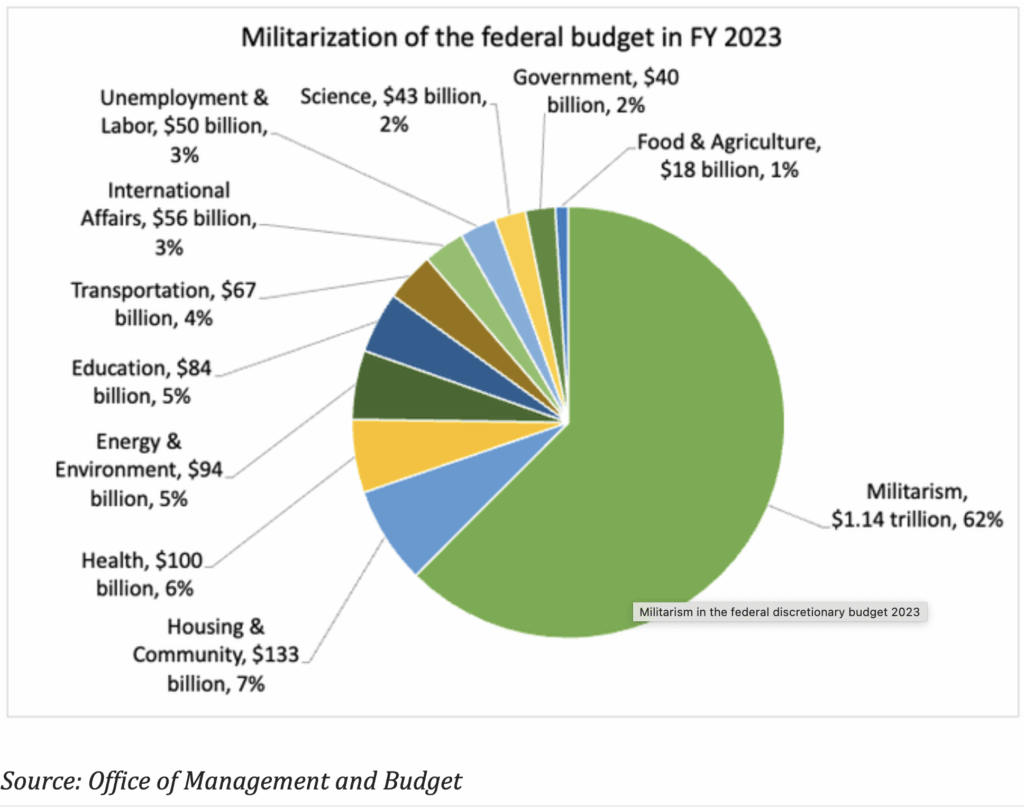
On January 17, 1961, in his farewell address, President Dwight Eisenhower warned that the “conjunction of an immense military establishment and a large arms industry is new in the American experience” and that “we must guard against the acquisition of unwarranted influence, whether sought or unsought, by the military-industrial complex. The potential for the disastrous rise of misplaced power exists and will persist.”
He was right. Today the military-industrial complex – the network of weapons-producing corporations, the Pentagon and members of Congress – has its tentacles in every congressional district and is the most influential force in Washington. Military spending has risen astronomically for decades and has now bankrupted the country. What’s more, the U.S. billionaires’ reliance on war to accomplish their international goals threatens to provoke a nuclear war.
Yet military spending continues to rise, and it’s being paid for with cuts to the services hundreds of millions depend on. While Trump is proposing a $119 billion increase in military spending for fiscal 2026, his budget proposal includes $700 billion in cuts to Medicaid and the Affordable Care Act. “It’s not just about losing a program. It’s about losing the very resources that allow us to live,” said Vashti Hayes, speaking to the crowd from her wheelchair during a mid-May protest in Oakland about the proposed Medicaid cuts the U.S. House is now considering.
There are three broad components to the federal budget: Discretionary spending makes up 26% of the budget, while 61% is mandatory spending, and 13% is interest on the national debt. Discretionary spending requires that annual appropriations bills be approved to finance it, while mandatory spending is mandated by existing law and only changes if changes are made in the laws or programs involved.
Mandatory spending includes Medicare and Medicaid, Social Security, income support programs like SNAP, veterans programs and federal retirement programs. Discretionary spending includes things like the military, homeland security, education, disaster assistance, environmental protection, public housing, and federal law enforcement.
According to the National Priorities Project, “In fiscal year 2023, out of a $1.8 trillion federal discretionary budget, $1.1 trillion — or 62 percent— was for militarized programs. That includes war and weapons, law enforcement and mass incarceration, and detention and deportation. Less than $2 out of every $5 in federal discretionary spending was available to fund investment in people and communities, including primary and secondary public education, housing programs, child care programs, federal disaster relief, environmental programs, and scientific research.” (See the chart below on militarization of the federal discretionary budget.)

Real U.S. military spending is much higher than the government claims. By one estimate, in 2022, actual U.S. military spending was more than $1.5 trillion – more than twice the officially acknowledged level. And the Pentagon has never passed an audit of its books; the Defense Department cannot account for trillions of dollars that it has spent over decades.
Military spending has contributed hugely to the national debt that has bankrupted the country. As Ren Brabenec wrote in the Tennessee Lookout in 2023, “In 2000, U.S. debt was $3.5 trillion, equal to 35% of Gross Domestic Product (GDP). By 2022, the debt had risen to $24 trillion, 95% of GDP. Had the debt remained at 35% of GDP from 2000 to 2022, it would have risen to $9 trillion. How did the U.S. government incur $15 trillion in excess debt? Most of it was military spending. Between 2001 and 2022, the U.S. spent $8 trillion on war.”
Interest on the national debt has become the fastest-growing part of the federal budget — exceeding the rate of growth of both Social Security and Medicare. Currently, the United States spends more than $2.6 billion every day on interest payments on its $36 trillion national debt.
America’s wars of choice since 9/11, including Afghanistan, Pakistan, Iraq, Syria, Libya, Yemen, Ukraine and Palestine, have killed millions of people and now threaten to expand and destroy the whole world. Growing pluralities of Americans support reducing American interventions abroad and engaging in more diplomacy and cooperation with other countries. Yet the influence of the military industrial complex, and the US elite relying on war as an instrument of national policy, interferes with moving in this direction. We could reduce military spending by hundreds of billions by closing the 800 US military bases outside the US, ending the wars of choice, and negotiating new arms control treaties with Russia and China. This would free money for human needs and keep our economy from collapsing under a national debt that now exceeds our GDP. Either we become a force for peace in the world, or our economy collapses and the world ends in war.
Congress is securely in the hands of the military-industrial complex and we cannot rely on it to do what is necessary. We, the people, are going to have to come out into the streets and impose the necessary changes, even if it means shutting the country down. We have the power to decide the future. Let’s use it.
Bob Lee is a professional journalist, writer and editor, and is co-editor of the People’s Tribune, serving as Managing Editor. He first started writing for and distributing the People’s Tribune in 1980, and joined the editorial board in 1987.

